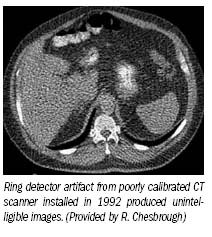- AI
- Molecular Imaging
- CT
- X-Ray
- Ultrasound
- MRI
- Facility Management
- Mammography
Outpatient imaging audit uncovers quality wasteland
An in-depth look at outpatient imaging services in Southeast Michigan has uncovered a wasteland of outpatient imaging where technologists are poorly trained, imaging is interpreted without written records, and films are allowed to pile up in patient waiting rooms.
An in-depth look at outpatient imaging services in Southeast Michigan has uncovered a wasteland of outpatient imaging where technologists are poorly trained, imaging is interpreted without written records, and films are allowed to pile up in patient waiting rooms.
This is the world that radiologist Dr. Richard M. Chesbrough and his RadMetrics consulting firm discovered for Blue Care Network, a private insurer that covers about 500,000 lives. The researchers examined 3794 studies from 100 imaging providers for a year ending in July 2008. About 31% of the exams-the equivalent of $2.6 million of global billings-were defective.

Chesbrough reported at the 2009 RSNA meeting that 11% of the sample studies had significant quality defects that potentially led to missed pathology or inappropriate therapy. They included studies where the selected field-of-view made it impossible for the clinician to fully appreciate the presence or extent of disease. Ultrasound studies were performed with the wrong transducer or printed for interpretation on xerographic paper. Obsolete equipment produced spinal images so poor that rudimentary aspects of anatomy could not be seen.
Physicians frequently violated rules governing direct supervision for iodinated contrast agents. In one instance, a primary-care physician admitted he was unaware that a crash cart was required, Chesbrough said.
Chesbrough found that untrained medical assistants were frequently performing x-rays, technologists without specialized training were performing diagnostic breast or musculoskeletal ultrasound, and primary-care physicians were interpreting advanced imaging applications performed in their offices.
About 20% of the studies involved coding, compliance, or billing mistakes, Chesbrough said. These included studies that lacked physician orders for the examination or were based on inappropriate indications, he said. Some studies were billed under complete diagnostic CPT codes even though only limited studies were actually performed.
Providers in the study included primary-care physicians, podiatrists, chiropractors, orthopedic surgeons, independent diagnostic testing facilities, for-profit imaging centers, and radiologist-owned imaging services. The only chronic problem attributed to radiologists was their tendency to perform comprehensive CT for all patients when limited views should have been performed in some instances, Chesbrough said.
In addition to their public health implications, the findings are relevant to radiologists because of the increasing drift of imaging volume to these types of services, Chesbrough said. He noted that 75% of outpatient imaging is performed by nonradiologists.
“This is a megatrend. More imaging is moving into an unregulated and unsupervised environment,” Chesbrough said. “We are witnessing the dumbing down of medical imaging.”
Emerging Perspectives on PSMA PET Radiotracers: An Interview with Kenneth J. Pienta, MD
April 24th 2024In a recent interview, Kenneth J. Pienta, M.D., discussed the impact of piflufolastat F18, current directions in research with other PSMA-targeted radiotracers and future possibilities for the role of PSMA PET in the imaging paradigm for prostate cancer.
Study Reveals Benefits of Photon-Counting CT for Assessing Acute Pulmonary Embolism
April 23rd 2024In comparison to energy-integrating detector CT for the workup of suspected acute pulmonary embolism, the use of photon-counting detector CT reduced radiation dosing by 48 percent, according to newly published research.
